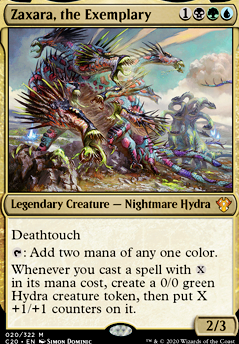
How To Turn a Hydra Into a Dark Ritual: A Primer
Commander / EDH* Aristocrats BUG (Sultai) Combo Competitive Tribal
Creature (25)
- 1x Capricopian
- 1x Cryptic Trilobite
- 1x Endless One
- 1x Erebos, Bleak-Hearted
- 1x Eternal Witness
- 1x Feral Hydra
-
1x
Genesis Hydra

- 1x Hangarback Walker
- 1x Hungering Hydra
- 1x Hydroid Krasis
- 1x Ivy Elemental
- 1x Mistcutter Hydra
- 1x Phyrexian Marauder
- 1x Pitiless Plunderer
- 1x Primordial Hydra
- 1x Protean Hydra
- 1x Shifting Wall
- 1x Steelbane Hydra
- 1x Stonecoil Serpent
- 1x Syr Konrad, the Grim
- 1x Thassa's Oracle
- 1x Tribute Mage
- 1x Ugin's Conjurant
- 1x Walking Ballista
- 1x Zulaport Cutthroat
Instant (9)
- 1x Assassin's Trophy
- 1x Blue Sun's Zenith
- 1x Chord of Calling
- 1x Cyclonic Rift
- 1x Force of Vigor
- 1x Gravepurge
- 1x Pull from Tomorrow
- 1x Swan Song
- 1x Whir of Invention
Planeswalker (2)
Land (30)
- 1x Blighted Woodland
- 1x Bojuka Bog
- 1x Breeding Pool
- 1x Command Tower
- 1x Drowned Catacomb
- 1x Dryad Arbor
- 1x Fabled Passage
- 5x Forest
- 1x Hinterland Harbor
- 3x Island
- 1x Misty Rainforest
- 1x Myriad Landscape
- 1x Opulent Palace
- 1x Overgrown Tomb
- 1x Path of Ancestry
- 1x Polluted Delta
- 1x Prismatic Vista
-
1x
Reliquary Tower

- 3x Swamp
- 1x Verdant Catacombs
- 1x Watery Grave
- 1x Woodland Cemetery
Artifact (11)
Commander (1)
Sorcery (12)
- 1x Decree of Pain
- 1x Dread Return
-
1x
Farseek

- 1x Finale of Devastation
- 1x Mind Spring
- 1x Nature's Lore
- 1x Postmortem Lunge
- 1x Rampant Growth
- 1x Search for Tomorrow
- 1x Stir the Grave
- 1x Wildest Dreams
- 1x Wurmcalling
Enchantment (10)
Maybeboard
Instant (1)
Sorcery (1)
Suggestions
Updates Add
Comments
Attention! Complete Comment Tutorial! This annoying message will go away once you do!
Important! Formatting tips — Comment Tutorial — markdown syntax
Please login to comment
91% Casual
Competitive
| Date added | 4 years |
| Last updated | 4 years |
| Exclude colors | WR |
| Legality | This deck is Commander / EDH legal. |
| Rarity (main - side) | 7 - 0 Mythic Rares 45 - 0 Rares 23 - 0 Uncommons 14 - 0 Commons |
| Cards | 100 |
| Avg. CMC | 2.26 |
| Tokens | Bird 2/2 U, Hydra 0/0 G, Thopter 1/1 C, Treasure, Wurm */* G |
| Folders | EDH Concept Decks |
| Votes | |
| Ignored suggestions | |
| Shared with | |
| Views |
